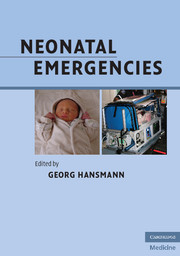Book contents
- Frontmatter
- Contents
- List of contributors
- Foreword (1)
- Foreword (2)
- Preface
- Acknowledgments
- Section 1 Organization of neonatal transport
- Section 2 Basics in cardiopulmonary resuscitation of newborn infants
- Section 3 Classic and rare scenarios in the neonatal period
- Management of healthy, term newborn infants (vaginal delivery, cesarean section, vacuum extraction, forceps delivery)
- Management of preterm and moderately depressed term newborn infants with a birth weight ≥1500 g
- Management of very preterm newborn infants (VLBW, ELBW)
- Twin–twin (feto–fetal) transfusion syndrome
- An apparently trivial call from the term baby nursery
- Out of hospital birth
- Hypoglycemia
- Meconium aspiration
- Chorioamnionitis and early-onset sepsis in the newborn infant
- Perinatal hemorrhage
- Perinatal hypoxia-ischemia
- Cerebral seizures
- Infants born to mothers on psychoactive substances
- Prenatal and postnatal arrhythmias
- Critical congenital cardiovascular defects
- Patent ductus arteriosus of the preterm infant
- Persistent pulmonary hypertension of the newborn (PPHN)
- Congenital diaphragmatic hernia
- Pneumothorax
- Congenital cystic adenomatoid malformation of the lung (CAM, CCAM)
- Chylothorax
- Hemolytic disease of the newborn
- Hydrops fetalis
- Choanal atresia
- Esophageal atresia
- Gastrointestinal obstruction
- Necrotizing enterocolitis (NEC)
- Omphalocele and gastroschisis
- Neural tube defects
- Cleft palate
- Birth trauma: brachial plexus palsy, facial nerve palsy, clavicular fracture, skull fracture, intracranial and subperiosteal hemorrhage (cephalohematoma)
- Sudden infant death syndrome (SIDS)
- Questions for review
- References (Section 3)
- Section 4 Transport
- Section 5 Appendix
- Index
- Plate section
Meconium aspiration
from Section 3 - Classic and rare scenarios in the neonatal period
Published online by Cambridge University Press: 05 March 2012
- Frontmatter
- Contents
- List of contributors
- Foreword (1)
- Foreword (2)
- Preface
- Acknowledgments
- Section 1 Organization of neonatal transport
- Section 2 Basics in cardiopulmonary resuscitation of newborn infants
- Section 3 Classic and rare scenarios in the neonatal period
- Management of healthy, term newborn infants (vaginal delivery, cesarean section, vacuum extraction, forceps delivery)
- Management of preterm and moderately depressed term newborn infants with a birth weight ≥1500 g
- Management of very preterm newborn infants (VLBW, ELBW)
- Twin–twin (feto–fetal) transfusion syndrome
- An apparently trivial call from the term baby nursery
- Out of hospital birth
- Hypoglycemia
- Meconium aspiration
- Chorioamnionitis and early-onset sepsis in the newborn infant
- Perinatal hemorrhage
- Perinatal hypoxia-ischemia
- Cerebral seizures
- Infants born to mothers on psychoactive substances
- Prenatal and postnatal arrhythmias
- Critical congenital cardiovascular defects
- Patent ductus arteriosus of the preterm infant
- Persistent pulmonary hypertension of the newborn (PPHN)
- Congenital diaphragmatic hernia
- Pneumothorax
- Congenital cystic adenomatoid malformation of the lung (CAM, CCAM)
- Chylothorax
- Hemolytic disease of the newborn
- Hydrops fetalis
- Choanal atresia
- Esophageal atresia
- Gastrointestinal obstruction
- Necrotizing enterocolitis (NEC)
- Omphalocele and gastroschisis
- Neural tube defects
- Cleft palate
- Birth trauma: brachial plexus palsy, facial nerve palsy, clavicular fracture, skull fracture, intracranial and subperiosteal hemorrhage (cephalohematoma)
- Sudden infant death syndrome (SIDS)
- Questions for review
- References (Section 3)
- Section 4 Transport
- Section 5 Appendix
- Index
- Plate section
Summary
! The ABCD rule especially applies to neonates with meconium-stained amniotic fluid (MSAF) and possible depression (i.e., bradycardia, cyanosis, apnea/inadequate breathing).
! Clear the AIRWAY rapidly! (see “Suctioning the newborn”, p. 66). See Figure 3.5, Table 3.4.
A prospective study, where the indication for cesarean section was frequently made because of postmaturity (prolonged pregnancy) or suspected asphyxia, showed no significant difference between 1-min and 5-min Apgar scores for neonates who were born through either clear or meconium-stained amniotic fluid (MSAF). Only a few neonates with MSAF seem to develop meconium aspiration syndrome (MAS) under these measures.
Meconium aspiration syndrome (MAS)
Definition
Aspiration of meconium-stained fluid has occured in a then severely depressed, unstable neonate. Laryngoscopy reveals viscous, MSAF/thick mucus behind the vocal cords (i.e., in the trachea).
Epidemiology
Incidence is about 7/1000 (up to 16/1000) live births. Approx. 5% of newborn infants with MSAF develop MAS.
Etiology/pathophysiology
The intrauterine passage of meconium rarely occurs before 37 weeks of gestation, but often after the 42nd week of gestation (30%–35%). Meconium passage is often an intrauterine reaction to stress caused by hypoxia (e.g., cord compression in oligohydramnios), acidemia or infection (amniotic infection syndrome, often in premature rupture of the membranes, PROM). Meconium aspiration can happen before or after birth. The worse the 1-min Apgar score, the more likely it is that aspiration has occurred in utero. In preterm infants, MSAF is associated with higher mortality and morbidity and is therefore very concerning.
Risk factors for respiratory distress syndrome in neonates with MSAF
Oligohydramnios
Pathological cardiotocogram (CTG; fetal heart rate monitoring) indicating fetal hypoxia
[…]
- Type
- Chapter
- Information
- Neonatal Emergencies , pp. 269 - 279Publisher: Cambridge University PressPrint publication year: 2009



